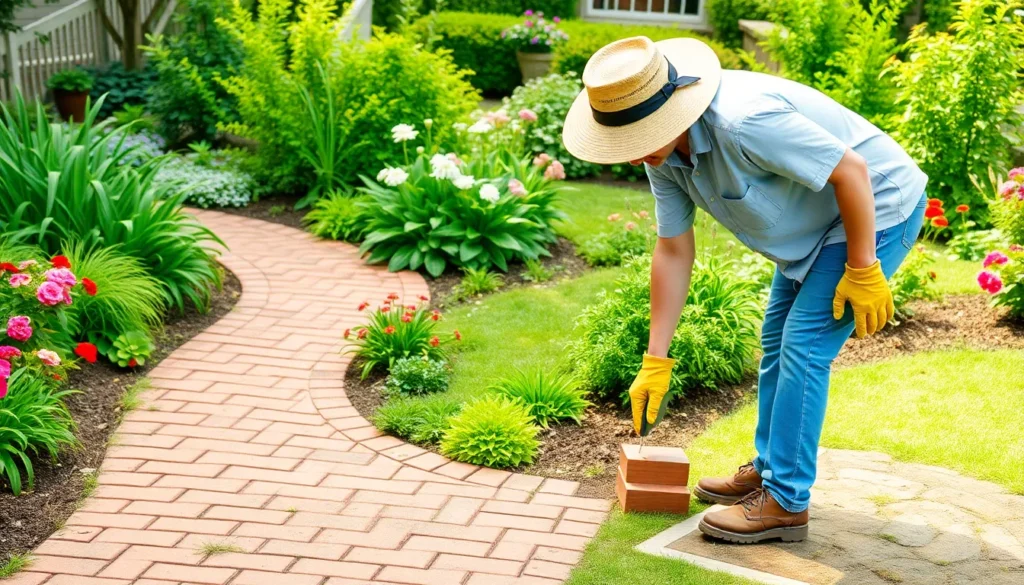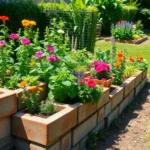Garden pavers transform ordinary outdoor spaces into stunning focal points that boost both beauty and functionality. Whether you’re dreaming of a cozy patio retreat or a sophisticated walkway, the right paving stones can completely revolutionize your industry design while adding substantial value to your property.
We’ve discovered that choosing the perfect pavers isn’t just about aesthetics – it’s about creating outdoor living spaces that reflect your personal style and meet your practical needs. From classic brick patterns that evoke timeless charm to modern concrete slabs that deliver sleek sophistication, today’s paver options offer endless possibilities for creative expression.
The best part? Many of these paver projects can dramatically enhance your garden’s appeal without very costly or requiring professional installation. We’ll explore innovative design ideas that work for every budget, space size, and skill level, helping you create the outdoor oasis you’ve always envisioned.
Create Stunning Pathways With Traditional Brick Pavers
Traditional brick pavers offer an enduring foundation for garden pathways that never goes out of style. We’ll explore how these versatile materials can transform your outdoor spaces with classic charm and practical durability.
Classic Red Brick for Timeless Appeal
Red brick pavers bring warmth and character to any garden setting with their rich terracotta hues. We recommend choosing weathered red bricks for an authentic aged appearance that complements both traditional and contemporary landscapes. These pavers work exceptionally well alongside white picket fences, cottage gardens, and colonial style homes.
Standard red brick pavers typically measure 8 inches by 4 inches and cost between $0.50 to $1.50 per square foot. We’ve found that reclaimed red bricks offer superior character with their naturally worn edges and varied color tones. Installing these pavers requires minimal maintenance beyond occasional sweeping and pressure washing every few years.
Herringbone Pattern for Visual Interest
Herringbone brick patterns create ever-changing visual texture that draws the eye along your garden pathways. We suggest alternating 45 degree angles to achieve the classic zigzag effect that makes narrow walkways appear wider. This pattern works particularly well for high traffic areas since the interlocking design provides excellent stability.
Creating herringbone patterns requires precise measurements and careful planning to ensure proper alignment. We recommend starting from the center point and working outward to maintain symmetry throughout your pathway. Professional installers charge between $8 to $15 per square foot for herringbone brick work, though determined DIY enthusiasts can complete smaller projects with patience and attention to detail.
Curved Walkways for Natural Flow
Curved brick pathways soften harsh lines in your garden design while creating an inviting sense of discovery. We prefer gentle S curves or subtle arcs that follow the natural contours of your industry rather than forcing straight geometric lines. These flowing pathways work beautifully around flower beds, water features, and mature trees.
Laying curved brick paths requires cutting individual pavers to fit the radius of your design. We suggest using a wet saw for clean cuts and renting professional equipment for larger projects. Border pavers help define the curved edges while preventing shifting over time. The gentle curves typically add 15% to 25% more material costs compared to straight pathways due to the additional cutting and fitting required.
Design Elegant Patios Using Natural Stone Pavers
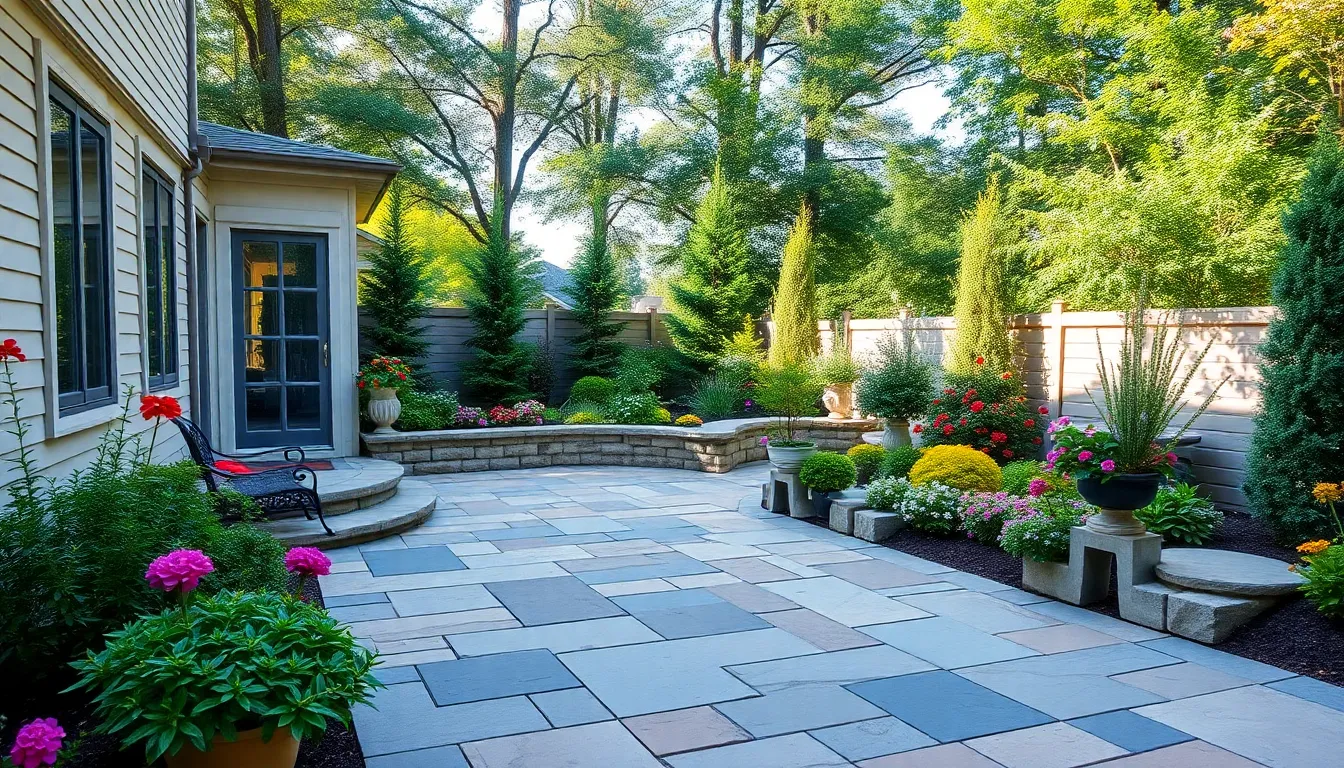
Natural stone pavers transform ordinary outdoor spaces into sophisticated retreats that seamlessly blend with your garden’s natural beauty. We’ll explore three exceptional stone options that create stunning patios with distinct character and lasting appeal.
Flagstone for Rustic Charm
Flagstone pavers deliver an authentic rustic aesthetic with their naturally irregular shapes and warm earthy tones. These flat stones create organic patterns that complement cottage gardens and country style landscapes perfectly. We recommend choosing weathered flagstone pieces that showcase natural variations in thickness and color for maximum visual interest.
Installing flagstone involves embracing the stone’s natural edges rather than forcing uniform spacing. Gravel joints between stones enhance the rustic appeal while providing excellent drainage for your patio surface. Plant low growing herbs like thyme or moss in wider gaps to create a living patio that evolves with your garden’s seasons.
Slate for Modern Sophistication
Slate pavers offer sleek surfaces and refined color palettes ranging from deep charcoal to sophisticated blue gray tones. These smooth stones create clean lines that work exceptionally well in contemporary garden designs and minimalist outdoor spaces. We find that slate’s naturally non slip texture makes it ideal for areas around pools or water features.
Geometric patterns showcase slate’s modern appeal most effectively. Rectangular slate pieces arranged in running bond or stacked patterns create visual rhythm across your patio surface. Large format slate tiles minimize grout lines for an uninterrupted contemporary look that emphasizes the stone’s natural beauty.
Limestone for Neutral Elegance
Limestone pavers provide timeless sophistication through their soft neutral colors and smooth refined finish. These versatile stones complement virtually any garden style from formal English gardens to casual Mediterranean courtyards. We appreciate limestone’s ability to reflect light and create bright welcoming patio spaces.
Consistent sizing makes limestone particularly easy to install in traditional patterns like ashlar or grid layouts. Tumbled limestone edges add subtle texture while maintaining the stone’s elegant character. Sealing limestone pavers protects against staining while preserving their natural beauty for decades of outdoor enjoyment.
Build Functional Driveways With Concrete Pavers
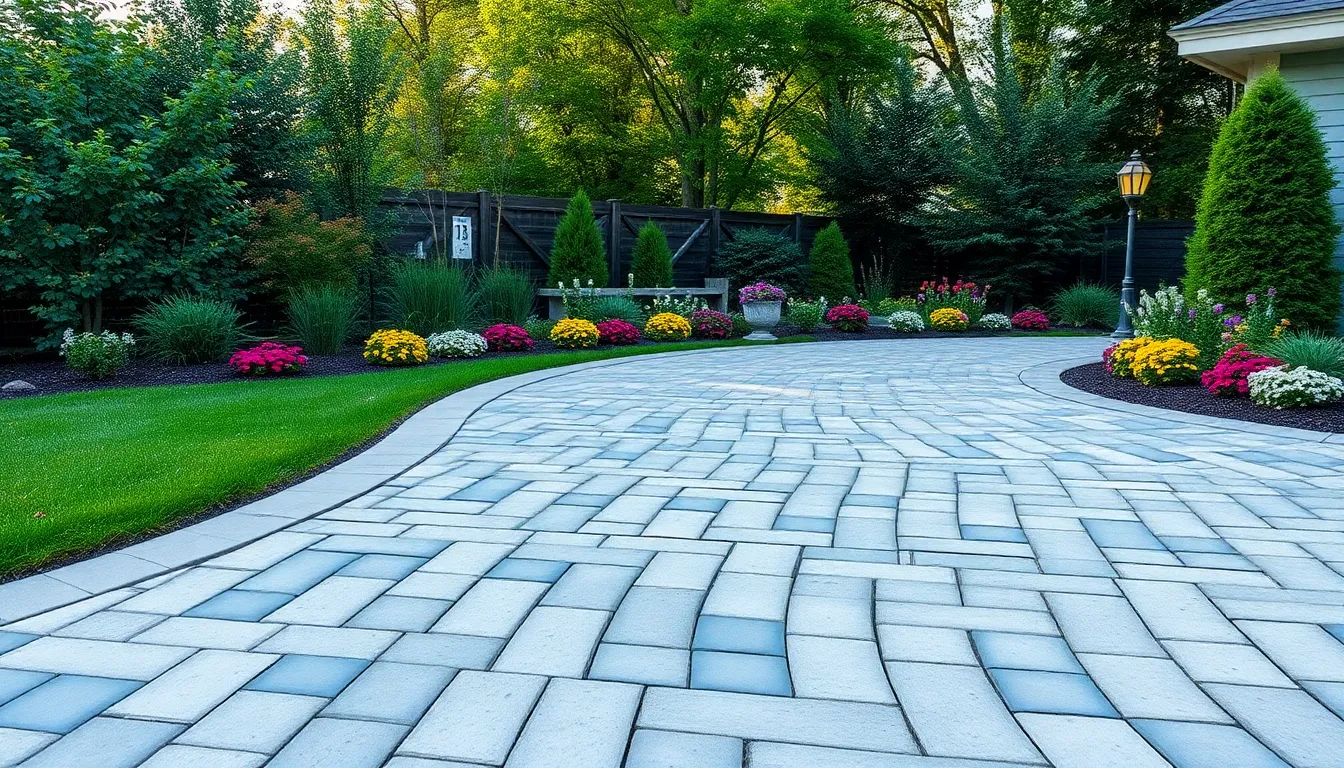
We can transform our driveways into stunning focal points that withstand heavy vehicle traffic while maintaining their beauty for years to come. Concrete pavers offer exceptional versatility for creating driveways that serve both practical and aesthetic purposes.
Interlocking Systems for Durability
Interlocking pavers create remarkable stability through their interconnected design, making them perfect for high-traffic driveway applications. Each paver locks seamlessly with its neighbors, distributing weight evenly across the entire surface and preventing individual stones from shifting or settling over time.
We recommend installing these systems with proper base preparation to maximize their longevity. Sand-set installations allow for easy maintenance since individual pavers can be removed and replaced without disturbing the surrounding area. Professional contractors often suggest using edge restraints to maintain the interlocking pattern’s integrity along driveway borders.
Heavy vehicles benefit from this design because the load spreads across multiple pavers rather than concentrating on single points. Freeze-thaw cycles won’t damage interlocking systems like they might affect solid concrete slabs, since the joints between pavers allow for natural expansion and contraction.
Permeable Options for Drainage
Permeable pavers address drainage concerns while meeting environmental regulations in areas with strict stormwater management requirements. Water flows through specially designed joints and porous materials, reducing runoff and preventing pooling on driveway surfaces.
We’ve found these systems particularly valuable in regions with high rainfall, where traditional impermeable surfaces can cause flooding or erosion issues. The spaces between pavers fill with gravel or sand that filters water naturally as it passes through to the soil below.
Installation requires exact base materials that promote drainage while maintaining structural integrity. Engineers design these systems to handle typical residential vehicle loads while managing important water volumes during storm events. Maintenance involves periodic cleaning of the joints to ensure continued water infiltration.
Colored Concrete for Customization
Colored concrete pavers offer unlimited design possibilities that can complement any architectural style or industry theme. We can choose from earth tones like terracotta and sandstone for traditional homes, or select bold colors like charcoal and slate blue for contemporary designs.
Integral coloring creates consistent hues throughout each paver, ensuring color retention even as surfaces experience normal wear from vehicle traffic. Surface treatments can add texture and depth, creating pavers that mimic natural stone or brick at a fraction of the cost.
Manufacturers now produce pavers in dozens of standard colors, with custom color matching available for exact design requirements. We recommend viewing samples in different lighting conditions since colors can appear different in morning sunlight versus evening shadows. Weather-resistant pigments maintain their vibrancy through years of exposure to UV rays and temperature fluctuations.
Establish Beautiful Borders With Decorative Pavers
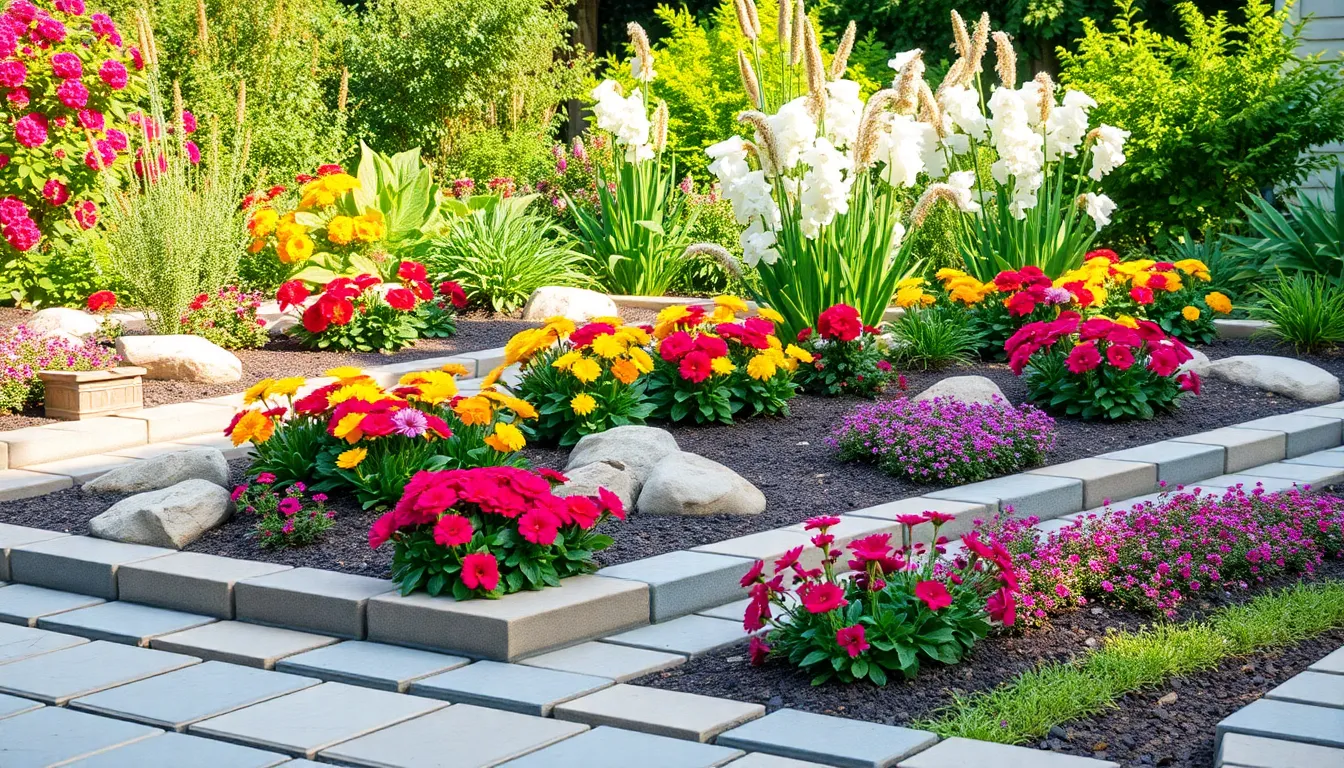
Creating stunning borders with decorative pavers transforms ordinary garden spaces into professionally designed landscapes. These versatile materials offer endless possibilities for defining areas while adding visual appeal to our outdoor environments.
Edging for Garden Beds
Garden bed edging becomes effortless when we choose pavers made from natural stone or concrete materials. These durable options can easily be cut to fit around curves or irregular shapes in our landscaping design. Functionality improves significantly as pavers help contain mulch or soil within the garden bed, preventing it from spilling over onto paths. We’ll find that maintenance becomes simpler when borders stay clearly defined throughout the growing season.
Color variety allows us to create visually appealing borders around garden beds that add depth and character to our outdoor spaces. Pattern designs like cobblestone or circular arrangements create unique and inviting borders that complement our existing industry features. Natural stone pavers offer rustic charm while concrete options provide modern versatility for contemporary garden styles.
Accent Strips Between Lawn and Industry
Visual separation becomes striking when we use thin strips of pavers between lawn areas and flower beds or other industry features. These narrow borders create clean lines that define different zones within our garden layout. Maintenance benefits include reduced need for frequent lawn edging, making our gardening tasks easier throughout the year.
Installation of accent strips requires minimal excavation compared to larger paver projects. We can choose materials that match our existing hardscape elements or select contrasting colors for dramatic effect. These strips work particularly well in formal garden designs where precise boundaries enhance the overall aesthetic.
Raised Borders for Definition
Elevated looks emerge when we create raised borders using pavers to define different areas within the garden, such as between flower beds and vegetable gardens. These structures add dimensional interest while providing practical benefits for plant organization. Drainage improvements occur naturally as raised borders allow water to flow away from certain areas, protecting sensitive plants from waterlogged conditions.
Construction of raised borders offers flexibility in height and width based on our exact garden needs. We can stack pavers to create substantial barriers or use single layers for subtle definition. Materials like limestone reflect light effectively while darker stones like slate provide sophisticated contrast against colorful plantings.
Transform Pool Areas With Water-Resistant Pavers
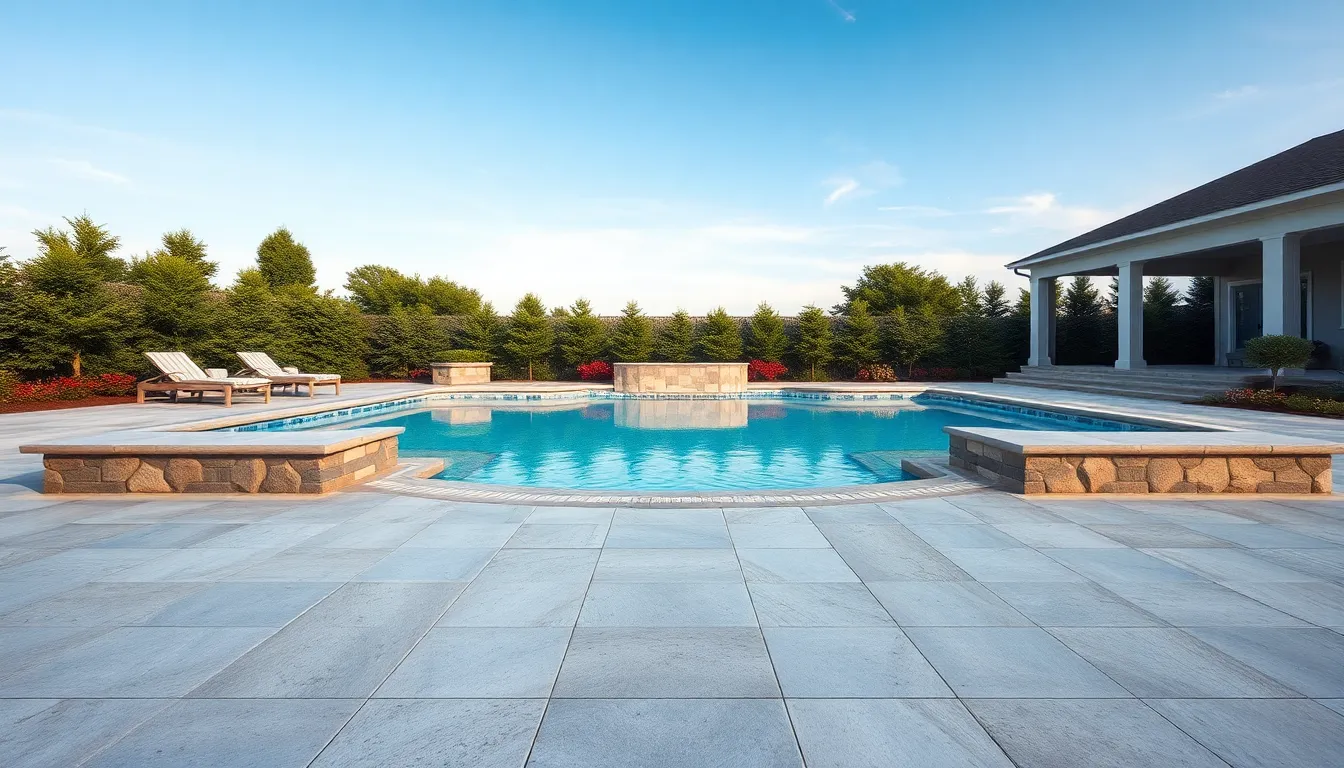
Pool areas deserve pavers that combine beauty with practical water resistance. We’ve found that concrete and natural stone materials excel in these wet environments while maintaining their structural integrity year after year.
Non-Slip Surfaces for Safety
Textured pavers create essential grip around pool decks where wet feet frequently walk. We recommend selecting pavers with naturally rough surfaces or those specifically manufactured with anti-slip textures to prevent accidents.
Concrete pavers with brushed finishes provide excellent traction without sacrificing comfort underfoot. Natural stone options like sandstone and travertine offer inherent texture that becomes more pronounced when wet.
Pool step integration requires careful attention to slip resistance since these areas experience constant water exposure. We suggest using pavers with deeper texture grooves or raised patterns that channel water away from walking surfaces.
Hot tub surrounds benefit from similar textured treatments since steam and splashing create consistently damp conditions. Choosing pavers with consistent texture patterns ensures uniform safety across the entire pool area.
Heat-Resistant Materials for Comfort
Concrete pavers remain comfortable to walk on even during peak summer temperatures. We’ve tested various materials and found that concrete maintains lower surface temperatures compared to darker alternatives like asphalt or black stone.
Natural stone options including limestone and travertine naturally resist heat absorption. These materials reflect sunlight rather than absorbing it, creating cooler surfaces for bare feet during hot weather.
Brick pavers offer excellent heat resistance while providing classic aesthetic appeal around pool areas. Their thermal properties make them suitable for direct sun exposure without becoming uncomfortably hot.
Light colored pavers significantly reduce surface temperatures compared to darker alternatives. We recommend selecting pavers in cream, beige, or light gray tones to maximize comfort during summer pool activities.
Coordinated Colors for Cohesive Design
Color matching between pavers and existing pool features creates seamless visual flow throughout the space. We suggest selecting pavers that complement pool coping, outdoor furniture, and architectural elements for unified design.
Alternating color patterns add visual interest without overwhelming the pool area’s natural beauty. Combining two complementary shades in checkerboard or striped arrangements creates sophisticated geometric designs.
Pool decking benefits from neutral color palettes that won’t compete with water’s natural blue tones. Earth tones like tan, gray, and cream provide elegant backdrops that enhance rather than distract from pool areas.
Pattern integration using cobblestone or circular designs transforms standard pool decks into distinctive focal points. These decorative elements work especially well around pool perimeters where they frame the water feature beautifully.
Create Outdoor Living Spaces With Large Format Pavers
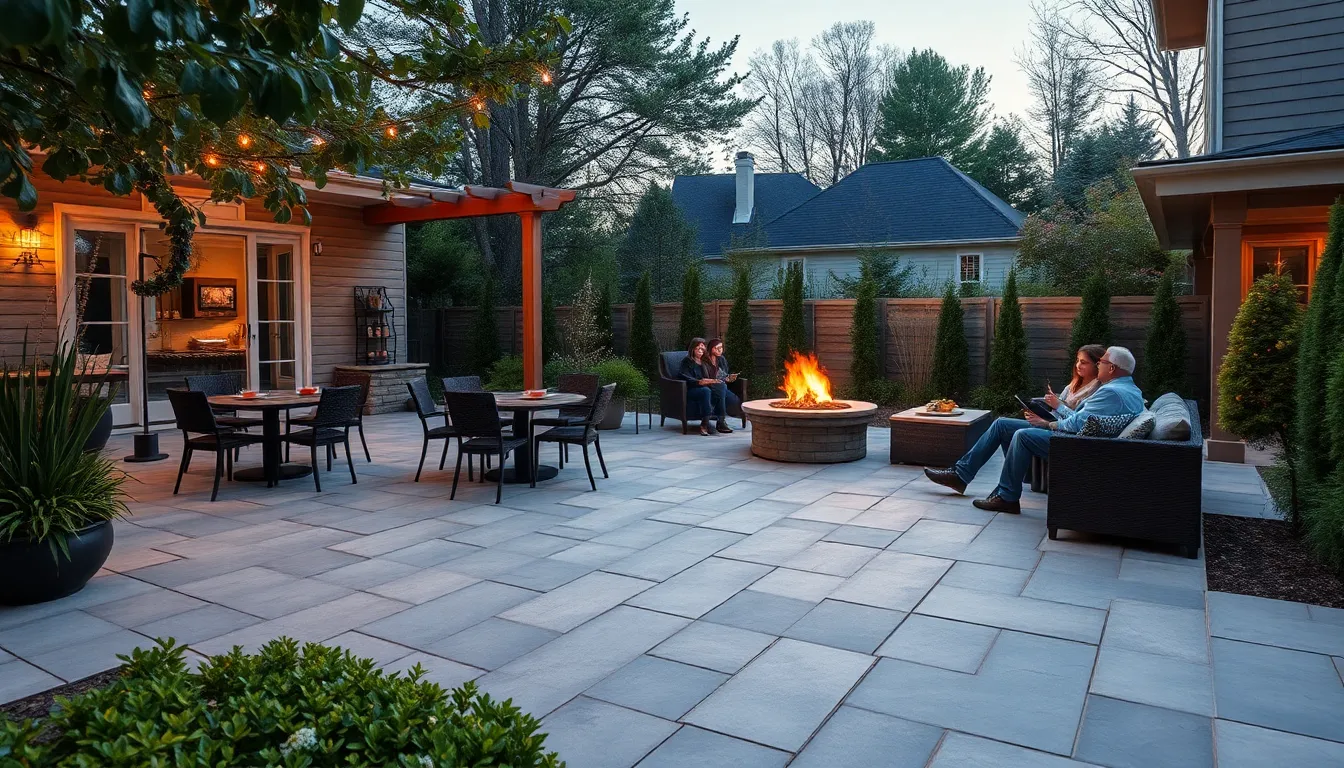
Large format pavers offer the perfect foundation for transforming your garden into sophisticated outdoor living spaces. We can design expansive areas that flow seamlessly together using these oversized pavers to create unified, elegant environments.
Entertainment Areas for Gatherings
Spacious patio designs become the heart of outdoor entertaining when we use large square pavers arranged in thoughtful patterns. Combining different paver sizes allows us to form extra-large squares separated by grassy joints, creating visual interest while maintaining an open feel for gatherings.
Diagonal paver patterns add ever-changing movement to entertainment spaces, especially when we incorporate wide joints that allow grass to grow through. This unique approach creates a natural carpet effect that’s both functional and visually appealing for hosting guests.
Outdoor bar areas benefit from the clean lines of large format pavers, which we can use to define exact zones within the entertainment space. These pavers blend seamlessly with other hardscaping features while providing a durable foundation for heavy furniture and high foot traffic.
Dining Spaces for Al Fresco Meals
Al fresco dining patios shine when we construct them with pavers that complement the surrounding industry and furniture choices. Large format pavers provide the stable, level surface needed for dining tables while creating a harmonious outdoor dining experience that feels intentional and designed.
Garden table placement becomes more flexible when we create paver covered areas surrounded by lush greenery. This approach allows us to position dining furniture exactly where we want it while maintaining the cozy, intimate setting that makes outdoor meals memorable.
Modern concrete pavers add rustic texture and natural appeal to dining spaces, blending effortlessly with garden elements. We can select finishes and colors that enhance the overall aesthetic while providing the durability needed for regular meal service outdoors.
Fire Pit Surrounds for Cozy Evenings
Fire pit area construction requires the safety and durability that large format pavers naturally provide. We can use these pavers to create proper fire pit surrounds that protect the surrounding industry while adding a sophisticated element to the outdoor space.
Circular seating arrangements work beautifully when we arrange pavers to form defined seating areas around fire pits. This design approach creates an ideal gathering space for chilly evenings with family and friends, encouraging conversation and connection.
Safety considerations become simpler with large format pavers, as they provide stable footing around fire features and resist heat better than smaller alternatives. We can design these areas to meet safety requirements while maintaining the aesthetic appeal that makes fire pit spaces so inviting.
Incorporate Eco-Friendly Pavers for Sustainable Gardens
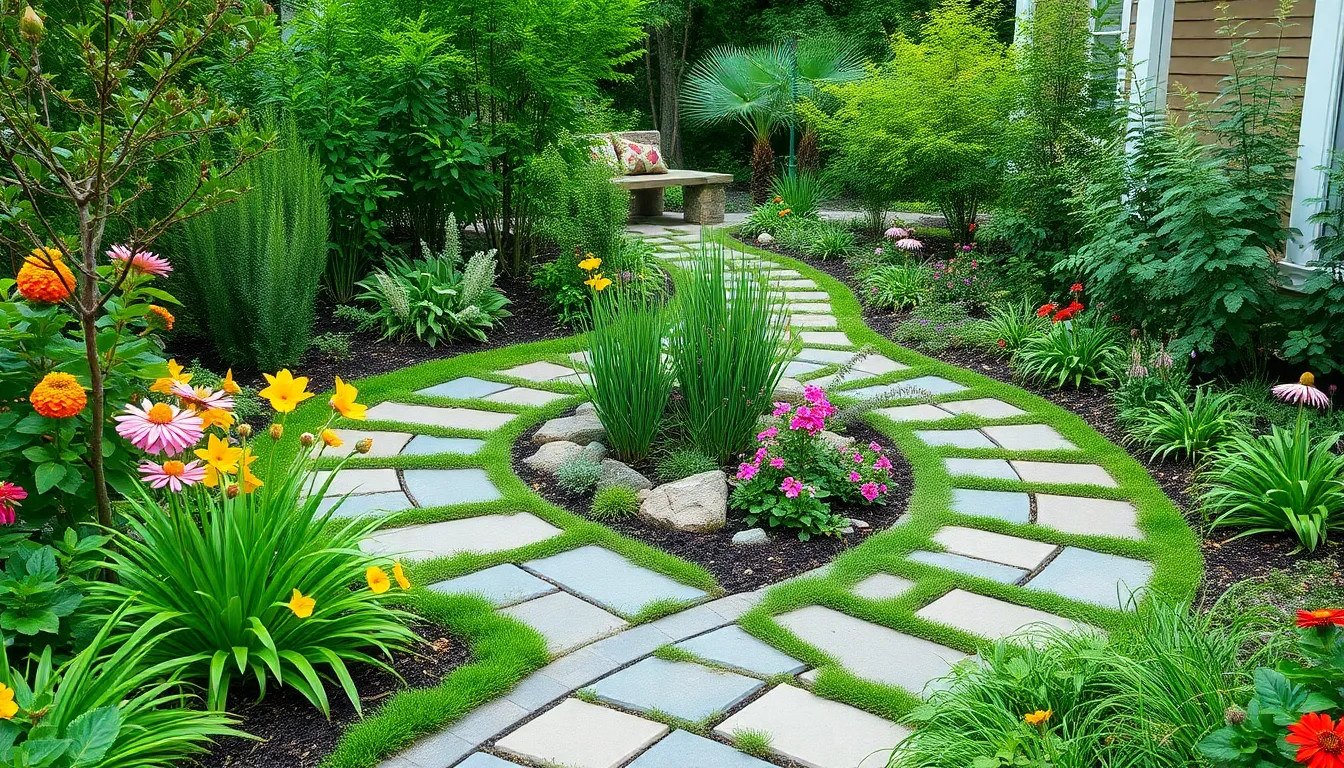
Sustainable garden design becomes achievable when we choose eco-friendly pavers that reduce environmental impact while maintaining durability and beauty. Modern sustainable paving answers help us create stunning outdoor spaces that align with our environmental values.
Recycled Materials for Environmental Benefits
Recycled concrete pavers offer exceptional durability while significantly reducing waste and conserving natural resources. These materials help us minimize the carbon footprint associated with new material production by reusing existing waste materials. Manufacturing processes for recycled pavers require less energy than creating new materials from scratch.
Maintenance requirements for recycled pavers remain minimal throughout their lifespan, making them cost-effective sustainable options for garden landscaping. We can find recycled pavers in various colors and textures that match traditional materials while providing superior environmental benefits. Installation techniques for recycled concrete pavers follow standard procedures, ensuring compatibility with existing industry designs.
Grass Pavers for Green Answers
Grass pavers create natural appearances while providing structural support for both foot traffic and vehicle movement in garden spaces. These permeable pavers allow grass to grow through designated openings, maintaining greenery while ensuring stability for driveways and pathways. Installation involves placing grid systems that support weight distribution while preserving root growth and natural drainage.
Maintenance for grass pavers requires regular watering and occasional reseeding to keep grass healthy and vibrant. We can use grass pavers in areas where maintaining natural aesthetics is essential, such as overflow parking areas or secondary walkways. Design flexibility allows us to integrate grass pavers seamlessly with traditional hardscaping elements.
Rain Gardens With Permeable Surfaces
Rain gardens collect and filter rainwater naturally, reducing stormwater runoff while improving overall water quality in our outdoor spaces. Permeable pavers serve as crucial components in these systems by allowing water to penetrate the ground and promote natural drainage processes. These installations reduce the need for storm sewers and help manage water flow during heavy rainfall events.
Strategic placement of permeable surfaces in rain gardens creates functional beauty while addressing environmental water management needs. We can design rain garden systems that complement existing industry features while providing essential drainage answers. Planning for rain gardens involves selecting appropriate permeable materials that match our garden’s aesthetic while maximizing water infiltration capabilities.
Add Artistic Elements With Mosaic and Patterned Pavers
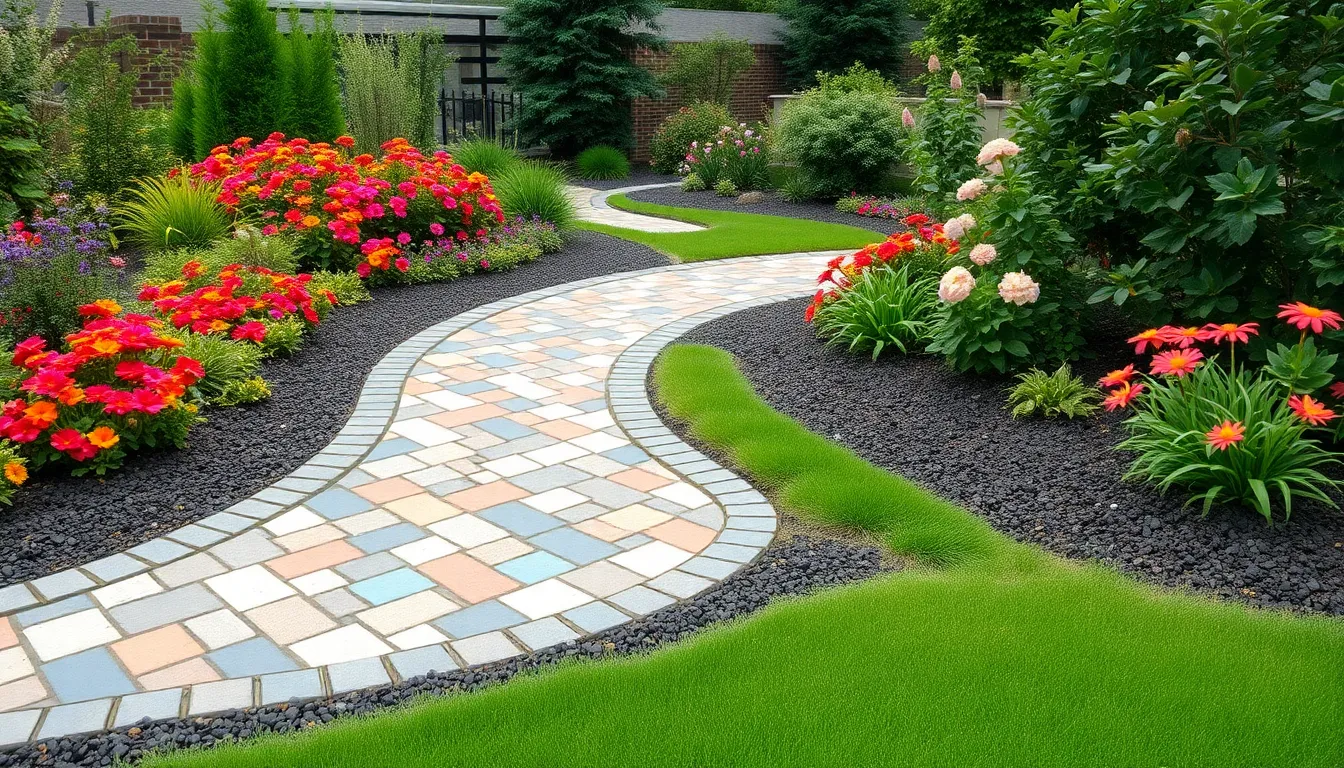
Transform your garden into a work of art by incorporating mosaic and patterned pavers that serve as both functional surfaces and stunning visual focal points. These creative paver answers allow us to express our personal style while adding distinctive character to outdoor spaces.
Mixed Material Combinations
Combining pavers with gravel creates rustic and earthy pathways that perfectly complement natural garden settings. We can achieve this look by alternating sections of pavers with gravel-filled spaces, allowing for proper drainage while maintaining a cohesive design aesthetic.
Pavers mixed with natural stone or brick add remarkable depth and texture to garden designs. This approach lets us create layered visual interest by incorporating materials with different colors, sizes, and surface textures throughout our outdoor spaces.
Contrasting materials work exceptionally well when we use light-colored pavers alongside darker gravel or vice versa. The combination provides natural definition between planting areas and walkways while reducing the overall cost of materials needed for larger projects.
Geometric Designs for Modern Appeal
Geometric patterns using pavers arranged in triangular or hexagonal shapes create striking modern designs that elevate contemporary garden spaces. We can carry out these patterns on patios, walkways, or as decorative accents within larger landscaped areas.
Symmetrical layouts provide clean and organized appearances that work particularly well in formal garden settings. These arrangements use consistent spacing and alignment to create visual harmony that complements structured planting designs and architectural elements.
Modern geometric designs benefit from using pavers in contrasting colors like light gray paired with charcoal or cream combined with deep brown. This color interplay emphasizes the geometric shapes while creating bold visual statements that anchor outdoor living areas.
Custom Patterns for Personal Expression
Personalized designs incorporating custom patterns or initials add distinctive touches that make our gardens uniquely ours. We can work with local suppliers to create custom-stamped pavers featuring family monograms, meaningful symbols, or decorative motifs that reflect our personal style.
Themed gardens benefit from pavers that incorporate exact colors or shapes matching our chosen design concept. Mediterranean themes might use terra cotta colored pavers in curved patterns, while Japanese-inspired gardens could feature rectangular pavers arranged in clean, minimalist lines.
Creative pattern combinations allow us to tell stories through our hardscaping choices. We might use different paver sizes to create flowing river-like patterns or arrange square pavers in checkerboard designs that add playful elements to children’s garden areas.
Design Multi-Level Landscapes With Stepped Pavers
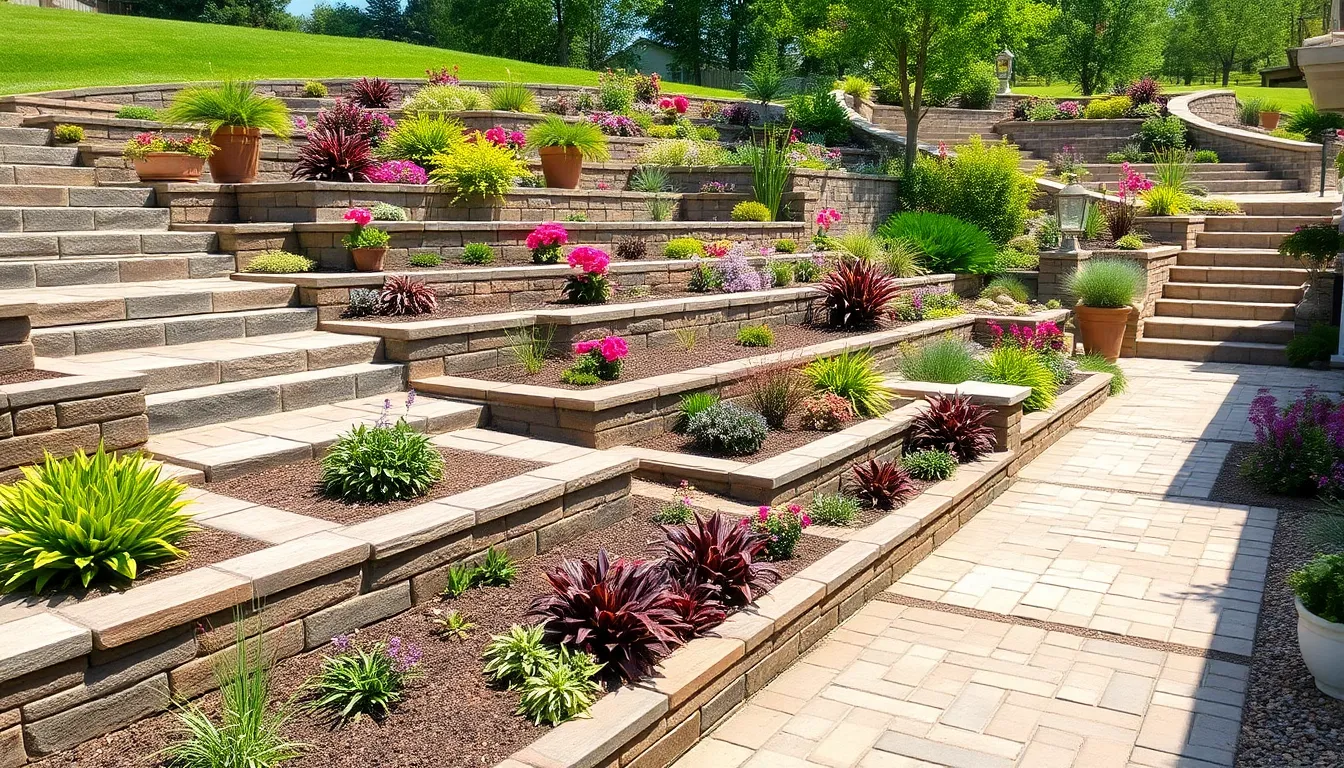
Stepped pavers transform challenging terrain into stunning garden masterpieces that showcase both form and function. We’ll explore how these versatile design elements create depth, structure, and visual appeal across varying elevations.
Terraced Gardens for Sloped Areas
Sloped areas become valuable garden real estate when we carry out terraced designs using stepped pavers. Each level serves as a distinct garden zone where we can cultivate different plant varieties or install unique features like water elements and seating areas.
Soil erosion becomes manageable through terracing since flat spaces require less maintenance than steep slopes. We create stable platforms that prevent water runoff while maximizing planting opportunities across previously unusable terrain.
Navigation improves dramatically when we define each terrace level with pavers that provide clear visual boundaries. Our stepped approach allows visitors to move safely between garden zones while appreciating the industry from multiple vantage points.
Retaining Wall Integration
Structural support becomes essential when we combine retaining walls with stepped pavers in terraced landscapes. This integration maintains soil integrity while preventing downhill sliding that could compromise our garden’s foundation.
Clean lines emerge naturally when we incorporate retaining walls that create distinct separations between garden levels. Our design gains professional polish through these defined boundaries that highlight different industry features.
Aesthetic appeal multiplies when we select retaining wall materials that complement our chosen pavers. We achieve cohesive looks by matching textures, colors, or styles that reinforce our overall garden theme.
Graduated Heights for Visual Drama
Visual interest intensifies when we use stepped pavers to create graduated height transitions throughout our garden space. This technique guides visitors naturally through different areas while highlighting exact features or focal points.
Accessibility improves significantly when we design gentle height changes rather than abrupt elevation shifts. Our graduated approach accommodates visitors of all mobility levels while maintaining the dramatic visual impact we desire.
Garden flow becomes intuitive when we strategically place stepped pavers that create natural pathways between elevated sections. We direct attention toward prize plants, sculptures, or seating areas through thoughtful height progressions that tell our garden’s story.
Conclusion
We’ve explored countless ways to transform your garden with creative paver answers that blend beauty with functionality. From eco-friendly options that support sustainability to artistic designs that showcase your personal style these ideas prove that every outdoor space has potential for enhancement.
Whether you’re working with a modest budget or planning an elaborate industry renovation the key lies in choosing materials and patterns that complement your garden’s unique character. The versatility of modern paver options means you can create everything from simple pathways to complex multi-level terraces.
Your garden deserves thoughtful design choices that will serve you well for years to come. With these innovative paver ideas you’re equipped to create an outdoor oasis that’s both practical and stunning.
Frequently Asked Questions
What are the main benefits of using garden pavers?
Garden pavers enhance both beauty and functionality of outdoor spaces. They offer durability, versatility, and can be customized to match personal style. Pavers provide stable surfaces for walkways, patios, and driveways while requiring minimal maintenance. Many projects can be completed affordably without professional help, making them accessible for various budgets and skill levels.
Which paver materials are best for different outdoor applications?
Brick pavers work well for classic pathways and high-traffic areas. Natural stone like flagstone, slate, and limestone create elegant patios with unique character. Concrete pavers are ideal for driveways due to their durability and customization options. Each material offers distinct advantages depending on your specific needs and aesthetic preferences.
Can I install pavers myself or do I need professional help?
Many paver projects can be completed as DIY endeavors with proper planning and basic tools. Simple pathways and small patios are particularly suitable for beginners. However, complex patterns, large areas, or projects requiring significant excavation may benefit from professional installation to ensure proper drainage and long-term stability.
What are eco-friendly paver options?
Eco-friendly options include recycled concrete pavers that reduce waste while maintaining durability. Grass pavers allow vegetation to grow through while supporting foot traffic. Permeable pavers help manage stormwater runoff and reduce environmental impact. These sustainable choices combine functionality with environmental responsibility for conscious gardeners.
How do I choose the right paver pattern for my space?
Consider your space’s style and function when selecting patterns. Herringbone offers stability for high-traffic areas, while curved layouts create natural flow. Geometric patterns suit modern designs, and mixed materials add visual interest. Choose patterns that complement your home’s architecture and enhance the overall landscape design.
What maintenance do pavers require?
Pavers require minimal maintenance compared to other surfaces. Regular sweeping removes debris, while occasional power washing keeps them clean. Weeds between joints can be managed with herbicides or manual removal. Some pavers may need resealing every few years, and damaged individual pieces can be easily replaced without affecting the entire surface.
How do stepped pavers work for sloped areas?
Stepped pavers create multi-level landscapes that transform challenging terrain into attractive features. They help manage erosion, improve navigation on slopes, and create distinct planting zones. Terraced designs with retaining walls provide soil stability while graduated heights add visual drama and guide visitors through the garden naturally.
What are the cost considerations for paver projects?
Costs vary based on material choice, project size, and installation complexity. Concrete pavers are typically most affordable, while natural stone costs more but offers unique beauty. DIY installation saves labor costs but requires time and effort. Consider long-term value, as quality pavers increase property value and require minimal replacement.

